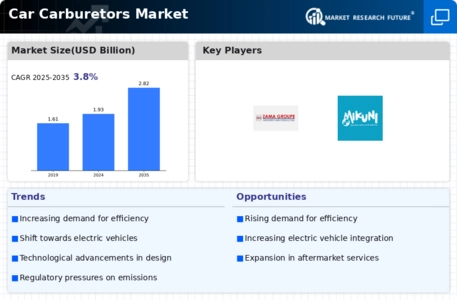Increasing Vehicle Production
The Global Car Carburetors Market Industry is poised for growth due to the increasing production of vehicles worldwide. As automotive manufacturers ramp up production to meet rising consumer demand, the need for carburetors is expected to surge. This trend is particularly evident in emerging markets where vehicle ownership is on the rise. The anticipated growth in vehicle production directly correlates with the demand for carburetors, thereby driving market expansion. The industry's ability to scale production in response to market needs will be crucial in maintaining competitiveness and meeting future demands.
Market Trends and Projections
The Global Car Carburetors Market Industry is characterized by various trends and projections that indicate future growth. The market is expected to reach a value of 2.82 USD Billion by 2035, with a compound annual growth rate of 3.5% from 2025 to 2035. This growth trajectory suggests a steady demand for carburetors driven by factors such as technological advancements, regulatory compliance, and increasing vehicle production. The market's evolution will likely be influenced by ongoing innovations and shifts in consumer preferences, making it essential for stakeholders to remain agile and responsive to these changes.
Growth of Aftermarket Services
The Global Car Carburetors Market Industry benefits from the growth of aftermarket services. As vehicle ownership increases, so does the demand for replacement parts and maintenance services. This trend is particularly pronounced in regions with a high concentration of older vehicles that require carburetor replacements. The aftermarket segment is expected to thrive as consumers seek cost-effective solutions for vehicle maintenance. This growth in aftermarket services not only supports the carburetor market but also encourages manufacturers to develop products that cater to the needs of this segment, thereby enhancing overall market dynamics.
Rising Demand for Fuel Efficiency
The Global Car Carburetors Market Industry experiences a notable increase in demand for fuel-efficient vehicles. As consumers become more environmentally conscious, manufacturers are focusing on optimizing carburetor designs to enhance fuel efficiency. This trend is reflected in the projected market value of 1.93 USD Billion in 2024, indicating a robust growth trajectory. Innovations in carburetor technology, such as electronic fuel injection systems, are likely to play a pivotal role in meeting these demands. The shift towards fuel-efficient vehicles not only aligns with regulatory standards but also caters to consumer preferences, thereby driving the market forward.
Regulatory Compliance and Emission Standards
Regulatory compliance plays a critical role in shaping the Global Car Carburetors Market Industry. Governments worldwide are implementing stringent emission standards to combat pollution and promote cleaner technologies. As a result, manufacturers are compelled to innovate and adapt their carburetor designs to meet these regulations. This necessity for compliance not only drives technological advancements but also influences market dynamics. The ongoing evolution of emission standards is likely to create opportunities for growth within the carburetor market, as companies that can effectively navigate these regulations will gain a competitive edge.
Technological Advancements in Carburetor Design
Technological advancements significantly influence the Global Car Carburetors Market Industry. Innovations such as variable venturi carburetors and advanced materials are enhancing performance and efficiency. These developments are crucial as they enable manufacturers to produce carburetors that meet stringent emission standards while improving overall vehicle performance. The market is expected to grow from 1.93 USD Billion in 2024 to 2.82 USD Billion by 2035, with a compound annual growth rate of 3.5% from 2025 to 2035. This growth is indicative of the industry's adaptability to technological changes and consumer demands for higher efficiency and lower emissions.







Leave a Comment